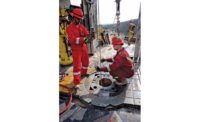NRG Energy, one of the nation’s largest power companies, made a big bet on renewable energy that has not played out well, least of all for the company’s chief executive, who was leading that charge.
On Dec. 3, NRG announced that David Crane was stepping down after 12 years at the helm. He is being replaced by chief operating officer Mauricio Gutierrez.
The changes leave many questions about what will happen to the Princeton, N.J.-based company’s renewable energy business, as well as it pipeline of construction projects.
Crane’s tenure at NRG was transformative. In 2009, he added a retail division to what had been strictly a power generation company with the $288-million acquisition of Reliant Energy with 1.7 million customers in Texas. In 2012, NRG became the biggest owner of power plants in the country when it bought GenOn Energy’s generation portfolio in a $1.7 billion deal.
NRG added to its portfolio in 2013 by buying a fleet of mostly coal-fired plants in the Midwest from Edison International, parent of Southern California Edison, for $2.6 billion.
Meanwhile, Crane was leading the charge into renewable energy, building some of the largest solar power plants in the country, such as the 392-MW Ivanpah in California’s Mojave Desert, the 250-MW California Valley Solar Ranch in San Luis Obispo County, and the 290-MW Agua Caliente solar facility in Yuma County, Ariz.
But over the past several years, Crane’s vision for renewable energy shifted away from large, utility scale renewable energy projects. Instead, he concentrated on smaller, distributed energy projects.
Crane set up new businesses to focus on the residential market for rooftop solar and on commercial markets such as sports stadiums and schools. He also launched EVgo, a chain of electric-vehicle charging stations.
The move away from the traditional generation business proved to be Crane’s undoing. NRG's share price has dropped about 60% year over year. Even a plan to spin off those new renewable businesses by year-end was not enough to stop the slide.
Plans for the spin-off are still on track, despite Crane’s departure, but the outlook for NRG’s once robust pipeline of renewable energy projects is less certain.
NRG Project Pipeline
Right now, NRG’s construction pipeline includes about 10 commercial projects – most are small, not even breaking the 1-MW mark – and there are no large solar or wind projects in the works.
NRG declined to detail what this transition will mean for its renewable energy pipeline, but in recent earnings discussions the emphasis has been on paying down debt and reducing capital expenditures.
The new chief executive comes from a more traditional generation background, so he could return to utility scale renewable energy projects.
But given the fact that NRG has re-doubled its focus on cost cutting and improving operations recently, analyst Julien Dumoulin-Smith, an analyst at UBS, says it is more likely that focus “will only intensify under Gutierrez’s control.”




